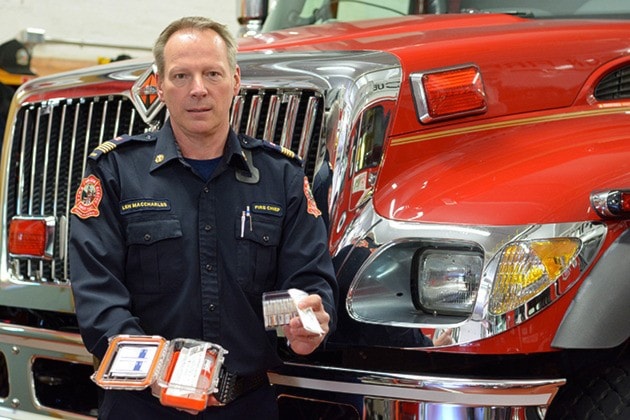All Nelson firefighters have recently taken training to administer Naloxone, a medication that will save lives in the event of overdoses of heroin, fentanyl, and other opioids.
Chief Len MacCharles said he signed his staff up for the training because “I wanted us to be in the best position to assist. Fire departments have quick response times. BC Emergency Health Services [which runs ambulances in BC] are under a lot of demand and so having fire departments as part of the solution is an important piece.”
According to BCEHS, there were 415 deaths from overdoses of illicit drugs in BC last year, with fentanyl detected in 30 per cent of them.
Naloxone is a medication that’s injected in the thigh or shoulder muscle when respiration is shut down by an opioid overdose and the patient is in danger of going into cardiac arrest. It restores breathing and has no known side effects. It has come into common use because of what Dr. William Dick, vice-president of medical programs for BCEHS, describes as an epidemic of opiate overdoses, often from fentanyl. A naloxone kit is pictured below (Bill Metcalfe photo).
 He said Naloxone training, which takes about three hours, covers the basics of what the drug is and how it works, plus practical instruction that expands on the first aid training that firefighters already have.
He said Naloxone training, which takes about three hours, covers the basics of what the drug is and how it works, plus practical instruction that expands on the first aid training that firefighters already have.
In short, if a patient is not breathing, they manage the airway, get the patient some oxygen, and give CPR if there is no pulse.
Then they call the 24-hour emergency physician support line, discuss the situation with the doctor and decide whether it appears to be a drug overdose.
Then, if advised by the doctor, they administer Naloxone — give one dose, continue airway management, and reassess. If there is no response, they give a second dose.
“Naloxone restarts breathing,” Dick says, “but it also wakes the brain up so the patient can manage their own airway and open it so they can breathe for themselves and don’t aspirate vomit.”
By this point, with any luck, the ambulance has arrived.
MacCharles says they were taught that Naloxone is a last resort and that there is no guarantee it will work.
“It depends on how much opioid was used. This is where it gets troublesome. I am not an expert, but with the synthetics that are coming out, there is a real range in the strength of the drug. Lots of things are getting laced with fentanyl, even marijuana, I have heard. Many young people are so unaware of the dangers of [fentanyl], that if I can save one life I want to do that.”
MacCharles said training firefighters to use Naloxone was started as a pilot project in Vancouver and Surrey last year.
“As soon as I heard about that, I contacted BCEHS and said as soon as it goes beyond pilot I want to be on the list. And they said okay.”
Dick explained that increases in overdoses in BC spurred recent changes in provincial government regulations, which previously did not allow firefighters to give intramuscular injections.
“This is new territory for firefighters,” he said.
